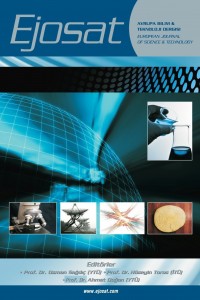Abstract
In recent years, different types of threats and attacks continue to increase in the internet world. It is important to detect anomalies in the time series quickly and accurately for web traffic data measured by the number of online visitors. Different methodologies and data classification techniques are used to detect abnormal traffic in network data. This problem is generally evaluated by classifying the signal windows by feature extraction. In this study, a method based on the Negative Selection Algorithm (NSA) of Artificial Immune Systems for the detection of abnormal web traffic on the network is proposed and a user-friendly application software is developed. For web traffic, the real data in the Yahoo Webscope S5 dataset is used and the data is split into windows using the window shift method. In the experimental studies, the detection of abnormal traffic data in the web traffic data is realized by monitoring the changes in the number of activated detectors in the NSA structure. On the application software developed in the study, it is observed that abnormal conditions in the web traffic data are detected with low error rates with NSA.
Keywords
Network security Web traffic data Anomaly detection Artificial immune systems Negative selection algorithm
References
- Kim, T.-Y. and Cho S.-B. (2018). Web traffic anomaly detection using C-LSTM neural networks, Expert Systems with Applications, 106, pp. 66-76.
- Symantec. Symantec Internet Security Threat Report, https://www.symantec.com/content/dam/symantec/docs/reports/istr-24-executive-summary-en-apj.pdf, Erişim Tarihi:09.06.2019.
- Münz, G., Li, S., and Carle, G. (2007). Traffic anomaly detection using k-means clustering, GI/ITG Workshop MMBnet, pp. 13-14.
- Thill, M., Konen, W., and Bäck, T. (2017). Online anomaly detection on the webscope S5 dataset: A comparative study. Evolving and Adaptive Intelligent Systems (EAIS), pp. 1-8.
- Akba, E. and Ergen, B. (2019). Kablosuz Yerel Alan Ağlarında Yapay Bağışıklık Sistemi ile Saldırı Tespiti ve Performans Analizi, http://www.emo.org.tr/ekler/8947fab05bee9c5_ek.pdf , Erişim Tarihi: 09.06.2019.
- Alkasassbeh, M., Al-Naymat, G., Hassanat, A., and Almseidin, M. (2016). Detecting distributed denial of service attacks using data mining techniques. International Journal of Advanced Computer Science and Applications, 7, pp. 436-445.
- Dutt, I., Borah, S., and Maitra, I. (2016). Intrusion Detection System using Artificial Immune System. International Journal of Computer Applications,144.
- Aziz, A. S. A., Salama, M. A., ella Hassanien, A., and Hanafi, S. E.-O. (2012). Artificial immune system inspired intrusion detection system using genetic algorithm Informatica. 36.
- Zheng, Y., Liu, Q., Chen, E., Ge, Y., and Zhao, J. L. (2014). Time series classification using multi-channels deep convolutional neural networks. International Conference on Web-Age Information Management, pp. 298-310.
- Computing Systems Data. S5-A Labeled Anomaly Detection Dataset. https://webscope.sandbox.yahoo.com, Erişim Tarihi: 09.06.2019.
- Yahmed, Y. B., Bakar, A. A., Hamdan, A. R., Ahmed, A., and Abdullah, S. M. S.(2015). Adaptive sliding window algorithm for weather data segmentation. Journal of Theoretical and Applied Information Technology, 80, p. 322.
- De Castro, L. N., and Timmis, J. (2002). Artificial immune systems: a new computational intelligence approach. Springer Science & Business Media.
- Dandıl, E. and Güngör, O. (2012). Yapay Bağışıklık Algoritmaları ile CNC Kesici Takım Aşınmalarındaki Değişimin Belirlenmesi. Akıllı Sistemlerde Yenilikler ve Uygulamaları Sempozyumu(ASYU 2012), Trabzon.
Abstract
Keywords
Ağ güvenliği Web trafik verileri Anomali tespiti Yapay bağışıklık sistemleri Negatif seçim algoritması
Thanks
Bu çalışmanın yazarları, çalışmada deneysel testler için kullanılan Yahoo Webscope S5 Veriseti kullanımına izin verdiği için Yahoo şirketine teşekkürlerini sunmaktadır.
References
- Kim, T.-Y. and Cho S.-B. (2018). Web traffic anomaly detection using C-LSTM neural networks, Expert Systems with Applications, 106, pp. 66-76.
- Symantec. Symantec Internet Security Threat Report, https://www.symantec.com/content/dam/symantec/docs/reports/istr-24-executive-summary-en-apj.pdf, Erişim Tarihi:09.06.2019.
- Münz, G., Li, S., and Carle, G. (2007). Traffic anomaly detection using k-means clustering, GI/ITG Workshop MMBnet, pp. 13-14.
- Thill, M., Konen, W., and Bäck, T. (2017). Online anomaly detection on the webscope S5 dataset: A comparative study. Evolving and Adaptive Intelligent Systems (EAIS), pp. 1-8.
- Akba, E. and Ergen, B. (2019). Kablosuz Yerel Alan Ağlarında Yapay Bağışıklık Sistemi ile Saldırı Tespiti ve Performans Analizi, http://www.emo.org.tr/ekler/8947fab05bee9c5_ek.pdf , Erişim Tarihi: 09.06.2019.
- Alkasassbeh, M., Al-Naymat, G., Hassanat, A., and Almseidin, M. (2016). Detecting distributed denial of service attacks using data mining techniques. International Journal of Advanced Computer Science and Applications, 7, pp. 436-445.
- Dutt, I., Borah, S., and Maitra, I. (2016). Intrusion Detection System using Artificial Immune System. International Journal of Computer Applications,144.
- Aziz, A. S. A., Salama, M. A., ella Hassanien, A., and Hanafi, S. E.-O. (2012). Artificial immune system inspired intrusion detection system using genetic algorithm Informatica. 36.
- Zheng, Y., Liu, Q., Chen, E., Ge, Y., and Zhao, J. L. (2014). Time series classification using multi-channels deep convolutional neural networks. International Conference on Web-Age Information Management, pp. 298-310.
- Computing Systems Data. S5-A Labeled Anomaly Detection Dataset. https://webscope.sandbox.yahoo.com, Erişim Tarihi: 09.06.2019.
- Yahmed, Y. B., Bakar, A. A., Hamdan, A. R., Ahmed, A., and Abdullah, S. M. S.(2015). Adaptive sliding window algorithm for weather data segmentation. Journal of Theoretical and Applied Information Technology, 80, p. 322.
- De Castro, L. N., and Timmis, J. (2002). Artificial immune systems: a new computational intelligence approach. Springer Science & Business Media.
- Dandıl, E. and Güngör, O. (2012). Yapay Bağışıklık Algoritmaları ile CNC Kesici Takım Aşınmalarındaki Değişimin Belirlenmesi. Akıllı Sistemlerde Yenilikler ve Uygulamaları Sempozyumu(ASYU 2012), Trabzon.
Details
| Primary Language | Turkish |
|---|---|
| Subjects | Engineering |
| Journal Section | Articles |
| Authors | |
| Publication Date | October 31, 2019 |
| Published in Issue | Year 2019 Special Issue 2019 |

